Contents
Strawberries are small and underdeveloped – many gardeners face this problem. The quality of the crop suffers for several reasons, most of them can be eliminated without much difficulty.
Why are strawberries clumsy, small, underdeveloped
Strawberries can bring low-quality and small crops due to improper agricultural practices, adverse climatic conditions, diseases or pests. It is customary to identify several main reasons for chopping berries.
Features of the variety
When choosing a strawberry variety for planting in a summer cottage, you need to carefully study its description. Some varieties of culture, in principle, are not capable of producing large berries. If the strawberries are juicy and neat, without obvious defects, but too small, it is likely that this is a varietal feature.
Before planting a crop, it is also necessary to study its requirements for growing conditions. For example, heat-loving varieties can bear fruit much worse in regions with a temperate and cold climate. Even with the right agricultural technology, the gardener will not be able to get big berries if the weather does not meet the requirements.
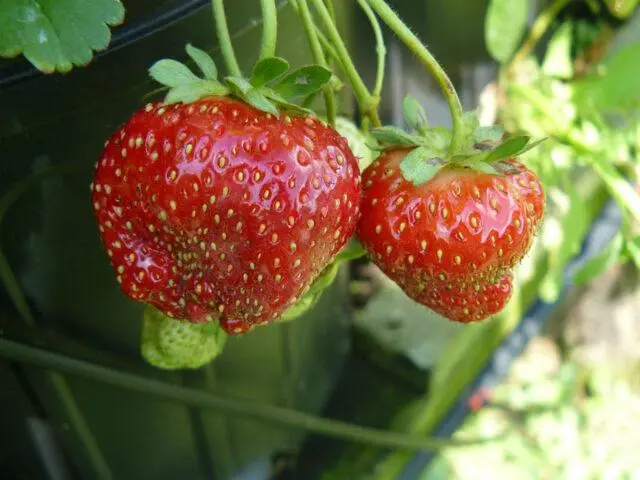
Large-fruited hybrid strawberries often become smaller when the variety is propagated by seeds
Landing degeneration
Often, strawberries begin to shrink a few years after planting. Usually the culture degenerates for 4-5 years, in which case it is necessary to renew the plantation.
It is recommended to plant new strawberries at the end of summer, partially replacing the old bushes in the garden. If the culture takes root well, then next year it will be possible to harvest a plentiful juicy harvest. In the event that new seedlings do not have time to lay flower buds before autumn, next season berries will still form on the remains of old bushes.
Frost during flowering
Small ovaries on strawberries are often formed due to late return frosts. The receptacle of opened buds is damaged by cold, darkens and deforms, the quality of pollination decreases. As a result, the plant still forms ovaries, but they develop poorly, and the berries turn out to be crooked and small.
Poor pollination
If the strawberries have many flowers and the berries are small, the cause may be poor pollination. Insects fly worse in rainy, cold and windy weather, collect less pollen. Against this background, the set fruits are not fertilized properly and cannot fully build tissues.
To improve pollination, it is recommended to spray beds with strawberries with a honey solution prepared at the rate of 20 g of sweetener per 1 liter of water. Processing of bushes is carried out in sunny and warm hours. It is recommended to plant honey plants near the strawberry beds, they will additionally attract bees to the site even in bad weather.
Diseases and pests
Small and deformed strawberries can be the result of pest activity – aphids, root nematodes, slugs and snails. Especially often, berry plantings on the site are damaged by the horsefly bug. You can learn about its presence both by small crooked fruits, and by spots and holes on the surface of the leaves.
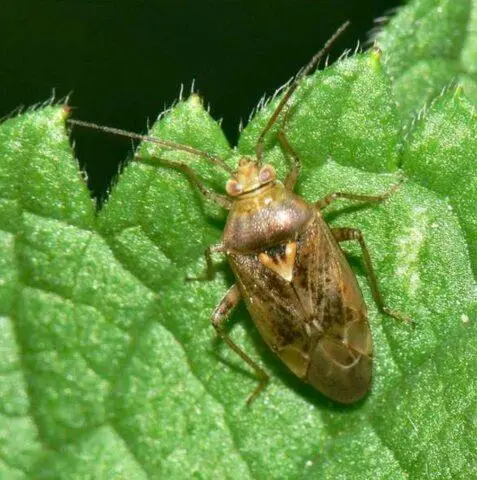
You can get rid of the bed bug by manual collection or spraying with soapy water.
If young strawberries are small due to the presence of pests in the beds, insects can be repelled with the help of other plants. For example, it is recommended to plant alfalfa between rows; it is of greater interest to parasites than berry crops. To scare away the blind bug, it is useful to place cimicifuga next to the beds, it has a sharp and unpleasant smell for the pest.
The quality of fruiting is affected by fungal diseases of strawberries. Bushes stop developing and form small deformed berries with verticillium, viral lesions, rust and powdery mildew. The presence of ailments is indicated by spots and plaque on the leaf plates. You can get rid of diseases in the first stages by spraying with copper preparations or fungicides.
Fungal diseases especially often affect strawberry beds when waterlogged. If the summer turned out to be damp and rainy, additional watering for the plantation is stopped.
Planting density
If strawberries bloom but the berries are small, it is possible that the problem is caused by planting too tightly. According to the rules of agricultural technology, bushes should be located at a distance of at least 30 cm from each other. Between rows leave about 70 cm.
With a closer landing, the bushes will take away moisture and nutrients from each other, and suppress the development of neighbors. Berries in this case will form, but will be small and rare. If the initial planting was carried out incorrectly, it is not necessary to put up with poor harvests. You can simply thin out the bed and remove some of the bushes so that the remaining ones begin to receive more sunlight, oxygen and nutrients.
Boron shortage
The amount of boron in the soil greatly affects the crop yield. If the element is not enough, it is necessary to feed the fruiting small strawberries. It is enough to shed the soil once with a solution of boric acid. For this, only 5 g of powder is diluted in a bucket of water, stirred and the beds are evenly treated with the resulting product.
Other reasons
If the strawberries are small and dry, this can be caused not only by the scarcity of the soil, diseases and return frosts. The yield is negatively affected by:
- insufficient watering – with a lack of moisture, strawberries dry and wrinkle;
- lack of sunlight – for full ripening, the culture needs more heat and ultraviolet light;
- abundance of tendrils – extra shoots take strength and resources from berry bushes, as a result, plants cannot form large fruits.
Small and dry strawberries can be encountered when buying low-quality seedlings. Before planting plants in the garden, you need to make sure that the roots and shoots of the bushes do not have defects and signs of disease.
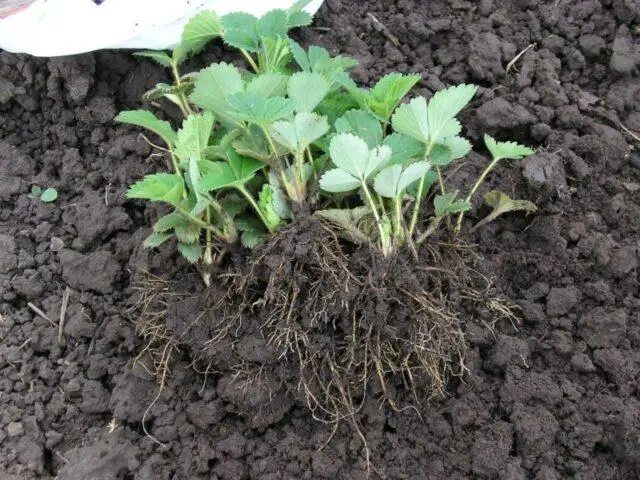
Before planting strawberries on the site, the roots of the seedlings should be treated in a fungicidal solution.
Why are strawberries small and leaves large?
Large strawberry bushes and small berries appear if there are enough nutrients in the whole culture, but resources are spent on the development of green mass, and not on the formation of fruits. This happens under the influence of several factors.
Clogged plantation
If the strawberry leaves are large and the berry is small, the reason may be clogging the beds. Low-quality fruits left lying on the plantation often germinate and form new bushes – abundant, but weak and low-yielding.
The main plantings in this case suffer from a lack of moisture and nutrients, strawberries become clumsy and hard. To prevent the situation, it is necessary to regularly inspect the plantation and remove all debris and crumbling small fruits in time.
Clogged beds can occur due to common weeds. Especially often they appear next to strawberries if the latter is grown on open soil without the use of film, spunbond or agrofibre. Self-seeding grasses take away water and nutrients from the fruit crop, and can impair the access of sunlight and oxygen to the bushes. Weeding the plantation is recommended at least twice a month.
Old shrubs
Even high-quality varietal strawberries cannot produce large, juicy berries for a long time. The fruits begin to shrink, usually at 4-5 years of age. At the same time, the bushes remain large and sprawling, they bloom magnificently, but there are very few berries, and they are crooked.
You can solve the problem by updating the beds. Instead of old strawberry bushes, young plants are planted and cared for in accordance with agricultural practices for the next 3-5 years.
Freeze damage
Gnarled strawberries can be caused by crop freezing in winter. Outdoor shrubs often suffer from poor or no cover during the winter months, especially if there is little snow and the frost is quite severe.
You can prevent crop chopping if you follow the rules of agricultural technology. Even frost-resistant strawberry varieties must be carefully covered with the onset of autumn with a mulch layer and non-woven material.
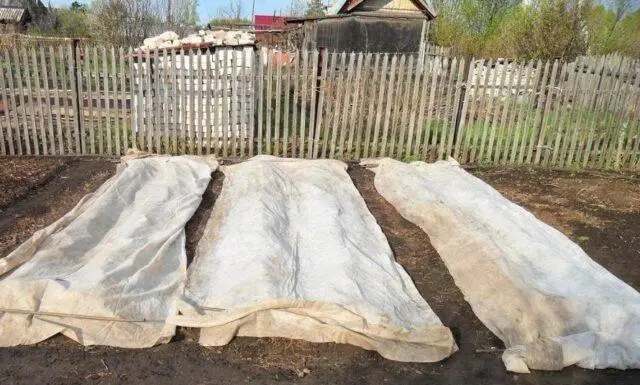
Shelter from strawberries is removed immediately with the onset of a thaw, so that the culture does not rot against the background of waterlogging.
What to do if there are a lot of small strawberries
If strawberries grow small, the causes can often be eliminated in the current season. To do this, you need to carefully examine the bushes and establish the source of the problem. Save the crop allow:
- abundant watering in dry and hot weather – at least twice a week;
- additional feeding with potassium and phosphorus;
- thinning thickened plantings;
- emergency elimination of pests or fungal diseases.
In order for the strawberries to be large and juicy, it is useful to treat the bushes with homemade nutrient solutions at the beginning of the formation of the crop. In particular, you can use:
- Pressed yeast. 5 kg of raw materials are diluted in 1 liters of water, a little sugar is added and mixed. The solution is infused in a warm place until the yeast is activated, and then 2,5 liters of the product are added to a bucket of water and 500 ml of the mixture is added under each strawberry bush.
- Mullein infusion. Dry manure is poured with liquid in a ratio of 1:10 and left for several days under a lid in a dark place. After a lapse of time, 1 liter of the product is diluted in a bucket of water, mixed and watered strawberries 1 liter under each bush.
- chicken manure solution. As in the previous case, it is necessary to pour dry fertilizer with liquid in a ratio of 1:10, keep under the lid for 3-4 days. Berry bushes are watered with a ready-made remedy under the root, without touching the aerial part.
As part of the fight against small crooked strawberries, it is recommended to pay attention to loosening the soil. If an earthy hard crust forms on the surface of the soil, the roots begin to receive less oxygen. Even with regular watering and timely feeding, in this case, strawberries can be crushed or get sick. Each time after wetting the beds, it is recommended to stir the soil to a shallow depth.
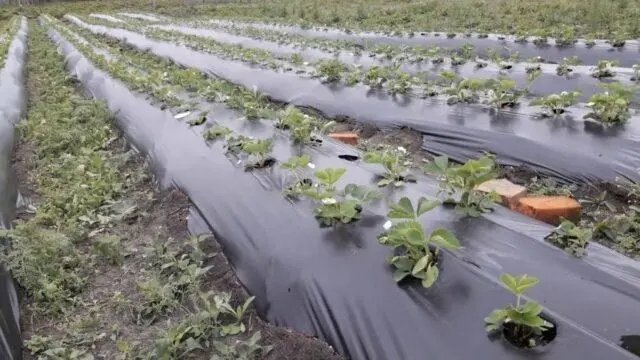
Refusing mulching and loosening allows growing strawberries under a film or spunbond
Conclusion
Strawberries are small, dry and clumsy – such a situation can be encountered due to a lack of watering and fertilizing, against the background of freezing of the culture, after the invasion of insect pests. The reasons for the deformation of the berries are quite amenable to elimination, but it is most often possible to get good fruits only in the next season.









